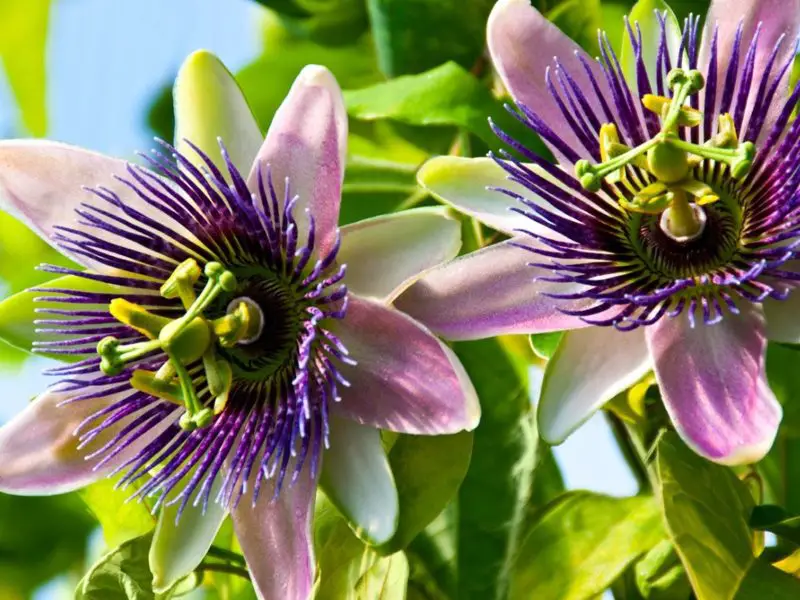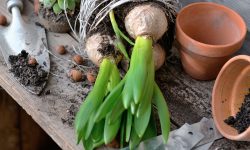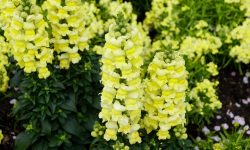Passion flowers captivate gardeners with their exotic beauty and intricate blooms. These striking vines bring vibrant colors and unique shapes to any garden, making them a favorite among plant enthusiasts. Growing passion flowers offers a rewarding way to enhance outdoor spaces with stunning floral displays that last through multiple seasons.
Whether you have a spacious garden or a cozy balcony, passion flowers adapt well to various environments. With the right care and techniques, you can enjoy their lush foliage and spectacular blossoms all year round. This guide will walk you through essential tips and expert advice to help your passion flower thrive and bloom vibrantly.
Understanding Passion Flower Basics

Passion flowers (genus Passiflora) are renowned for their exotic and complex blossoms. Native primarily to Central and South America, these plants thrive in warm temperate to tropical climates. Their flowers feature intricate shapes and vivid colors, often with contrasting corollas and styles that attract pollinators such as bees, butterflies, and hummingbirds.
These vigorous climbers use tendrils to attach themselves to nearby structures, making them ideal for vertical gardening or adding interest to fences, trellises, and pergolas. Passion flowers can grow as shrubs or sprawling vines, depending on species and conditions. Some varieties produce edible passion fruits, valued for their unique flavor and nutritional benefits.
Understanding their native environment helps gardeners replicate optimal growing conditions. Passion flowers prefer well-draining soil with moderate fertility and flourish in spots with morning sun and afternoon shade in hotter regions. Proper site selection is key to achieving healthy growth and abundant flowering.
Choosing the Right Passion Flower Variety
Tropical vs. Temperate Varieties
Tropical passion flowers like Passiflora edulis thrive in warm climates without frost. They often produce vibrant flowers and edible fruit. In contrast, temperate varieties such as Passiflora caerulea tolerate cooler temperatures and light frost. These types suit regions with distinct seasons and temperature changes. Understanding your local climate helps you select the right variety, ensuring healthy growth and consistent flowering.
Tropical varieties usually require more light and humidity. Temperate types are more drought-tolerant and easier to care for during colder months. Choosing the correct variety reduces weather damage risks and optimizes growing success.
Flower Color and Size
Passion flowers display a wide range of colors from deep purple, blue, bright red, to pure white. Some varieties have large, showy blooms perfect as focal points in large gardens. Smaller flowered types suit container growing or small trellises. Pick flower colors and sizes that harmonize with your garden’s design or intended space.
Flower color also affects pollinator attraction like bees, butterflies, and hummingbirds. Bright and contrasting hues improve pollination chances, supporting sustainable plant growth and garden health.
Growth Habit and Space Requirements
Certain passion flower types grow vigorously, quickly covering walls, fences, or arbors. These are ideal for large spaces needing fast coverage or decorative screening. Others have compact or bushy habits, suitable for smaller gardens or pots.
Consider your planting space and maintenance ability when choosing a variety. Vigorous climbers need sturdy supports and regular pruning to control size. Compact types are easier to manage and great for beginners.
Fruit Production
Many passion flower varieties produce edible fruit known as passionfruit. Popular types like Passiflora edulis or Passiflora ligularis are prized for their delicious and nutritious fruit. If you want both beautiful flowers and harvestable fruit, these varieties are ideal.
Fruit-bearing plants often require more sunlight and warmer climates to thrive. Care routines involve careful fertilizing and watering to support flowering and fruit set. Providing proper conditions will lead to a successful and rewarding harvest.
Preparing the Planting Site
Passion flowers thrive when planted in the right location with proper soil conditions. They require at least four to six hours of direct sunlight daily to bloom abundantly. In very hot climates, afternoon shade protects delicate leaves and flowers from scorching.
Soil quality greatly influences plant health. Passion flowers prefer fertile, well-draining soils that retain moisture without becoming soggy. Slightly acidic to neutral soil pH (6.0 to 7.5) is ideal. Incorporating organic matter such as compost or aged manure improves nutrient availability and soil structure.
Avoid low-lying areas prone to waterlogging, which can cause root rot. Good air circulation reduces the risk of fungal diseases. Selecting a sheltered spot away from harsh winds helps prevent physical damage to vines and supports.
Planting Passion Flower Seeds and Seedlings
Starting passion flowers from seed can be rewarding but requires patience. Seeds have a hard coat, so soaking them in warm water for 24 hours helps speed germination. Sow seeds in a moist, well-draining seed-starting mix, pressing them lightly into the surface but not covering deeply.
Maintain soil temperatures between 70°F and 80°F for optimal germination, which usually occurs within 2 to 4 weeks. Keep soil moist but not waterlogged. Seedlings emerge slowly and unevenly, so allow plenty of time and space.
Alternatively, growing from nursery seedlings offers faster results. When planting, dig holes twice the size of the root ball, loosen surrounding soil, and set plants at the original soil level. Space plants 6 to 10 feet apart, depending on growth habit. Water thoroughly after planting to settle soil around roots.
Watering and Moisture Needs for Passion Flowers
Watering Requirements
Passion flowers need consistent moisture, especially during active growth and flowering. Water deeply once or twice a week, depending on weather and soil type. Avoid letting the soil dry out completely, as this stresses the plant and reduces bloom production. However, overwatering can lead to root rot. Check soil moisture regularly by feeling about 2 inches deep; water when it feels dry.
During hotter months, increase watering frequency to compensate for evaporation. Container-grown passion flowers may require more frequent watering than garden-planted ones due to quicker drying of pots. Proper watering supports healthy leaves, vigorous growth, and abundant flowers.
Soil Moisture and Drainage
Well-draining soil is essential to prevent waterlogging around the roots. Passion flowers prefer moist but not soggy conditions. Incorporate organic matter like compost into the soil to improve water retention while maintaining good drainage. Mulching around the base helps conserve moisture and regulate soil temperature.
Avoid heavy clay soils that retain excess water and suffocate roots. If your soil tends to hold water, amend it with sand or perlite to enhance drainage. Good moisture management reduces the risk of fungal diseases and promotes strong, thriving passion flower vines.
Fertilizing Passion Flowers for Abundant Blooms
Feeding passion flowers appropriately boosts flower production and overall plant health. Use a balanced fertilizer such as a 10-10-10 or 20-20-20 formula during the growing season. Applying fertilizer every four to six weeks encourages lush foliage and vibrant blossoms.
A fertilizer higher in phosphorus (the middle number) promotes more prolific flowering. Slow-release or organic fertilizers work well to provide steady nutrients without risk of burning roots. Avoid excess nitrogen, which may cause dense leafy growth with fewer flowers.
In addition to commercial fertilizers, top-dressing with compost or organic mulch enriches the soil naturally. Regular feeding combined with proper watering maximizes passion flower performance.
Pruning Passion Flowers to Encourage Growth and Flowering
Pruning passion flowers helps maintain shape, control size, and stimulate flowering. Light pruning in early spring removes dead, damaged, or weak stems, allowing new growth to flourish. Removing old wood encourages fresh shoots, which produce more flowers.
Pinching back the tips of young vines early in the season encourages branching and fuller growth. After the first flowering flush, a light trim of spent flowers and stems can promote a second bloom cycle.
Avoid heavy pruning late in the season to prevent cutting off next year’s flower buds. Proper pruning increases airflow through the vine, reducing disease risk and improving garden aesthetics.
Supporting Passion Flowers: Trellising and Training
Trellising Options for Passion Flowers
Passion flowers are vigorous climbers that need sturdy support to grow well. Use trellises, arbors, fences, or pergolas to provide vertical space. Choose materials like wood, metal, or strong plastic that can withstand the vine’s weight. Proper trellising keeps plants off the ground, improving air circulation and reducing disease risk. It also showcases the beautiful flowers effectively.
Position the trellis in a sunny spot, as passion flowers need light to bloom abundantly. Secure young vines gently to supports using soft ties or garden twine to avoid damaging stems. Regularly check ties to prevent girdling as the plant grows thicker.
Training and Pruning Passion Flower Vines
Training involves guiding new growth along the trellis to shape the plant and encourage full coverage. Start training early by gently weaving or tying shoots to the support. This directs energy to producing flowers rather than tangled, unmanaged growth.
Prune passion flowers annually to remove dead or weak stems and promote fresh shoots. Light pruning after flowering encourages a second bloom cycle. Removing old growth improves overall plant health and airflow. Consistent training and pruning maintain a neat, vibrant display year-round.
Managing Pests and Diseases in Passion Flowers
Passion flowers are generally resilient but can face common pests such as aphids, whiteflies, and spider mites. Inspect plants regularly, especially the undersides of leaves. Early intervention prevents infestations from becoming severe.
Insecticidal soaps or neem oil sprays provide effective control with minimal harm to beneficial insects. Introducing natural predators like ladybugs helps maintain ecological balance.
Fungal diseases like powdery mildew and root rot may occur under poor air circulation or excessive moisture. Plant in well-drained soil, water at the base, and prune overcrowded growth. Remove diseased foliage promptly to prevent spread.
Overwintering Passion Flowers in Cooler Climates
In regions with frost, passion flowers require protection during winter. Potted plants can be moved indoors or to a greenhouse where temperatures stay above 50°F (10°C). Reduce watering and stop fertilizing during dormancy.
For garden-grown plants, apply a thick layer of mulch around the root zone to insulate roots. Wrapping vines with frost cloth or burlap protects above-ground parts from freezing temperatures.
Prune dead stems before winter to reduce damage risk. Some hardy species tolerate mild frost but still benefit from winter care to resume vigorous growth in spring.
Propagating Passion Flowers: Techniques for Growing More Vines
Propagating passion flowers is rewarding and can be done via seeds, cuttings, or layering. Seeds require scarification and stratification to germinate successfully, which may take several weeks. This method is slower but helps maintain genetic diversity.
Softwood or semi-hardwood cuttings taken in late spring or early summer root quickly. Dip cut ends in rooting hormone and plant in moist, well-draining soil or a soilless mix. Keep cuttings in a humid environment with indirect light until roots form, usually within 4 to 6 weeks.
Layering involves bending a low-growing stem to the ground, wounding it slightly, and covering it with soil. Roots will develop at the buried section, after which the new plant can be separated from the parent. This method produces vigorous new plants identical to the parent vine.
Understanding Passion Flower Growth Cycles and Blooming Patterns
Passion flowers typically bloom from late spring through fall, with peak flowering during warmer months. The length of the blooming season depends on the species, climate, and care. Some tropical species may bloom year-round in frost-free areas.
Vines produce flowers on new growth, so encouraging continuous shoot development through proper pruning and feeding extends blooming periods. Cooler temperatures and shorter daylight reduce flower production, leading to dormancy in colder zones.
Monitoring the growth cycle helps gardeners time pruning, fertilizing, and watering to maximize flowering. Knowing when your passion flower enters dormancy allows for appropriate care adjustments to prepare for the next season.
Tips for Container Growing Passion Flowers
Choosing the Right Container
Choose a large container, at least 15-20 inches in diameter, to allow ample root growth. Ensure the pot has good drainage holes to prevent waterlogging and root rot. Terracotta, ceramic, or plastic pots all work well but must be sturdy enough to support the growing vine.
Heavier pots like terracotta help stabilize the plant and prevent tipping as the vine grows. Select a pot deep enough to accommodate roots and retain moisture. Avoid small pots as they limit growth and cause the soil to dry out quickly.
Soil and Potting Mix
Use a well-draining, loose soil mix rich in organic matter to promote healthy root development. Avoid heavy garden soil as it retains too much water and may cause root problems. Adding perlite or coarse sand improves aeration and drainage.
Container soil should be nutrient-rich to support year-round growth. Incorporate organic compost or slow-release fertilizer to maintain soil fertility. Ensure the soil stays light and not compacted for easy water and nutrient absorption.
Watering and Fertilizing in Containers
Plants in containers need more frequent watering since soil dries out faster than in-ground beds. Keep the soil consistently moist but avoid waterlogging to prevent root damage. During hot seasons, increase watering frequency to reduce stress.
Feed your passion flower with a water-soluble fertilizer every 2-3 weeks during the growing season. Avoid excessive nitrogen, which encourages leafy growth but fewer flowers. Balanced feeding helps maintain strong, vibrant blooms.
Providing Support in Containers
Install a trellis or stakes inside the pot early to guide vine growth properly. Training the vine onto supports encourages vertical growth and better air circulation. Start training while the plant is young for easier management.
Support structures prevent branches from breaking under their own weight as the vine thickens. Shaping the vine also enhances the container’s visual appeal. Proper support reduces pest problems by improving airflow around the plant.
Enhancing Passion Flower Fragrance and Color
To enhance fragrance and vibrant color, provide optimal care with balanced nutrition, proper light, and humidity. Some passion flower varieties have stronger scents; choose cultivars like Passiflora caerulea for notable fragrance.
Regular watering during dry spells maintains healthy blooms with intense color. Avoid over-fertilizing with nitrogen, which can reduce flower quality. Increasing humidity around plants can also improve flower scent and durability.
Deadhead spent flowers to encourage continuous blooming and fresh scent release. Healthy, well-maintained passion flowers produce more fragrant, vibrant flowers that enliven any garden space.
Troubleshooting Common Problems with Passion Flowers
Pest Infestations
Passion flowers can attract pests like aphids, spider mites, and whiteflies. These insects suck sap from the leaves, causing yellowing and distorted growth. Early detection is crucial to prevent heavy infestations. Regularly inspect your plants, especially the undersides of leaves.
To control pests, use insecticidal soap or neem oil sprays. Introducing natural predators, such as ladybugs, can reduce pest populations. Avoid harsh chemical pesticides, which may harm beneficial insects. Maintaining plant health through proper watering and nutrition also reduces pest problems.
Fungal Diseases
Powdery mildew and leaf spot are common fungal issues for passion flowers. Powdery mildew appears as a white, powdery coating on leaves. Leaf spot causes brown or black patches on foliage. Both diseases weaken the plant and reduce flowering.
Prevent fungal diseases by ensuring good air circulation around plants. Avoid overhead watering to keep leaves dry. Remove and destroy infected leaves promptly. Applying fungicides early can help control outbreaks, but always follow label instructions.
Poor Flowering and Growth
Lack of flowers or weak growth often results from improper light or nutrition. Passion flowers need at least 4-6 hours of direct sunlight daily. Insufficient sunlight causes legginess and few blooms.
Soil that lacks nutrients also affects flowering. Use balanced fertilizers during the growing season. Avoid over-fertilizing with nitrogen, which promotes leaf growth but fewer flowers. Regular pruning encourages bushier plants with more flowers.
Environmental Stress
Extreme heat, cold, or drought stresses passion flowers, causing leaf drop and stunted growth. Protect plants from frost and strong winds, which can damage vines. Use shade cloth during hot summer days to reduce heat stress.
Water consistently to avoid drought stress but do not overwater. Well-drained soil prevents root rot caused by excess moisture. Stress weakens plants, making them more vulnerable to pests and diseases.
Root Problems
Root rot can occur when soil is poorly drained or watering is excessive. Affected plants show yellowing leaves, wilting, and slow growth. Roots become brown and mushy.
Prevent root rot by planting in well-draining soil. Water only when the top inch of soil feels dry. Repot container plants in fresh, airy soil if rot develops. Remove damaged roots to save the plant.
Harvesting Passion Flowers and Using Them
Passion flowers are prized not only for their beauty but also for their edible fruits in some species. Harvest flowers when fully open to enjoy their intricate design and fragrance. Cut early in the morning when flowers are freshest for bouquets or decoration.
For fruiting types, harvest passion fruits when they turn their characteristic color and slightly soften. Use fruits fresh or in jams, juices, and desserts. The flowers can also be dried for ornamental purposes or tea blends, preserving their delicate aroma.
Regular harvesting encourages new blooms and fruit production. Remove spent flowers to redirect energy into new growth and extend the blooming season.
Ecological Benefits of Passion Flowers in Your Garden
Passion flowers support local ecosystems by attracting pollinators like bees, butterflies, and hummingbirds. Their vibrant colors and nectar provide essential food sources, enhancing biodiversity.
They also offer habitat and shelter for beneficial insects that control garden pests naturally. This reduces the need for chemical pesticides and fosters a balanced garden environment.
Furthermore, passion flowers contribute to soil health by adding organic matter through leaf drop. Their vigorous growth can help stabilize soil and prevent erosion on slopes and embankments.
Planting passion flowers supports a sustainable, lively garden with both beauty and ecological value.
Propagation Methods for Passion Flowers
Passion flowers can be propagated by seeds, cuttings, or layering. Growing from seeds requires patience, as germination may take several weeks to months. To improve success, soak seeds overnight and plant them in warm, well-draining soil. Keep the soil moist and maintain a temperature between 70°F and 85°F (21°C to 29°C).
Propagation by cuttings is faster and more reliable. Take semi-hardwood cuttings in late spring or early summer, about 4 to 6 inches long. Remove the lower leaves and dip the cut end in rooting hormone. Plant the cutting in moist, well-draining soil or a propagation mix. Cover with a plastic dome or bag to maintain humidity until roots develop.
Layering is another effective technique for passion flowers. Select a low-growing stem and gently wound it. Bury the wounded part under soil, securing it in place. Roots form over several weeks, after which the new plant can be separated and transplanted.
Pruning and Maintenance for Vigorous Growth
Pruning passion flowers helps maintain shape, encourages new growth, and increases flowering. Perform light pruning in early spring by removing dead, damaged, or weak stems. This allows more energy for healthy shoots.
After the main blooming period, prune back long, unruly vines to promote a second flush of flowers. Avoid heavy pruning late in the season, which can reduce winter hardiness.
Regularly check the vine for overcrowded growth. Thin dense areas to improve air circulation and reduce fungal risk. Support climbing passion flowers with trellises or stakes, training new growth to prevent tangling.
Feeding after pruning supports recovery. Use a balanced fertilizer to encourage healthy leaf and flower development. Keep watering consistent but avoid waterlogging.
Soil Preparation and Fertilization for Passion Flowers
Healthy passion flowers start with well-prepared soil. These vines prefer fertile, well-draining soil rich in organic matter. Before planting, loosen the soil to at least 12 inches deep to promote root penetration. Incorporate compost or well-rotted manure to boost nutrient content and improve soil texture.
Passion flowers thrive in slightly acidic to neutral soil, with a pH between 6.0 and 7.0. If your soil is too alkaline or acidic, amend it accordingly to optimize nutrient uptake. Avoid heavy clay soils that hold excessive moisture and risk root rot.
For fertilization, apply a balanced fertilizer high in potassium and phosphorus to encourage abundant blooms. Use a slow-release granular fertilizer in early spring, then supplement with a liquid feed every 4 to 6 weeks during the growing season. Excess nitrogen can lead to excessive leaf growth at the expense of flowers, so balance is key.
Watering Best Practices for Passion Flowers
Consistent watering is critical for passion flower health. These plants prefer moist but well-drained soil. Water deeply once or twice weekly, depending on weather and soil conditions. Avoid letting soil dry out completely, especially during hot, dry spells.
Too much water can cause root rot. Always check that the soil surface has dried slightly before watering again. Mulching around the base helps retain soil moisture and regulate temperature, reducing watering frequency.
During flowering, maintain consistent moisture to support vibrant blooms. Reduce watering gradually in late fall as the plant enters dormancy or slows growth. For container-grown passion flowers, check moisture more frequently, as pots dry out faster than garden beds.
Dealing with Specific Pests and Diseases
Passion flowers can be affected by pests like aphids, spider mites, and whiteflies. These tiny insects suck sap from leaves and stems, causing yellowing, curling, and weakened growth. Early detection is key to preventing serious damage. Regularly inspect your plants, especially the undersides of leaves, for signs of infestation. Using insecticidal soap or neem oil sprays can control these pests effectively without harming beneficial insects.
Diseases such as root rot and powdery mildew may also affect passion flowers. Root rot usually develops in poorly drained soils and causes wilting and browning of roots. Powdery mildew appears as a white powdery coating on leaves and stems, reducing photosynthesis and vigor. To prevent these issues, ensure proper watering practices, good air circulation, and avoid overhead watering. Remove and discard infected plant parts promptly to stop spread.
FAQ About Growing Passion Flower
What is the best time to plant passion flower seeds?
The ideal time to plant passion flower seeds is in early spring, after the last frost. This timing ensures warm soil and favorable conditions for germination. Starting seeds indoors 6-8 weeks before transplanting outdoors can also improve success.
How much sunlight do passion flowers need to thrive?
Passion flowers require full sun to partial shade, ideally at least 6 hours of direct sunlight daily. Too little light reduces flowering, while too much harsh sun can stress the plant in hot climates.
How often should I water my passion flower plants?
Water regularly to keep the soil consistently moist but not waterlogged. Deep watering once or twice a week is usually sufficient, increasing frequency during hot, dry periods. Avoid letting soil dry out completely.
What are common pests and diseases affecting passion flowers?
Common pests include aphids, spider mites, and whiteflies. Diseases like root rot and powdery mildew can occur if conditions are too wet or humid. Proper watering and good air circulation help prevent most issues.
How can I encourage more blooms on my passion flower vine?
Regular fertilization with a balanced fertilizer high in phosphorus supports blooming. Prune lightly after flowering to stimulate new growth. Ensure adequate sunlight and consistent moisture for best flower production.
Conclusion
Growing passion flowers is a rewarding experience that adds vibrant beauty and unique charm to any garden or space. By understanding their specific needs—from selecting the right location and soil to providing proper care, watering, and protection against pests and diseases—you can ensure healthy growth and abundant blooms throughout the year. Regular maintenance, including pruning and feeding, further supports strong vines and prolonged flowering periods. Whether you are a beginner or an experienced gardener, patience and attention to detail will help you enjoy the stunning, intricate flowers passion vines offer. With the right care, your passion flower will thrive and become a captivating focal point, enriching your garden’s biodiversity and aesthetic appeal for many seasons to come.






